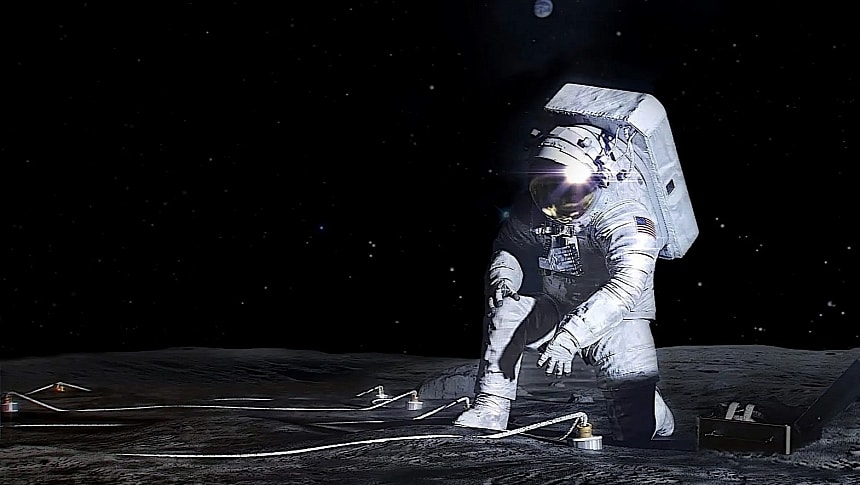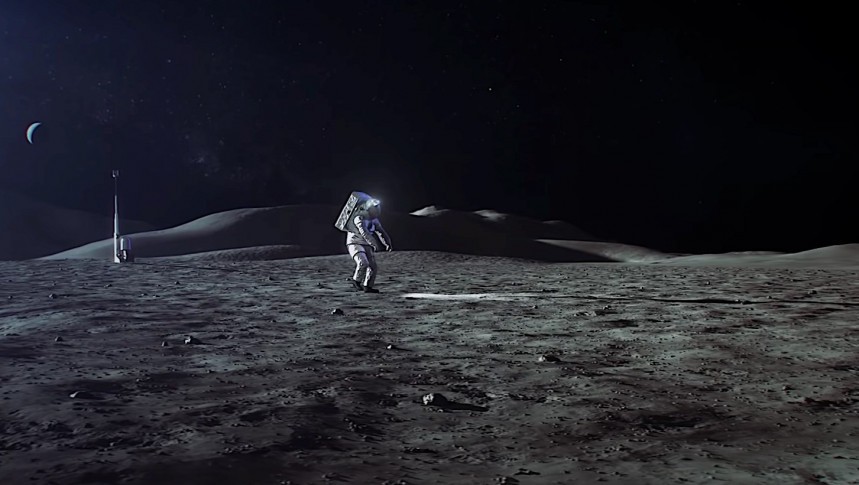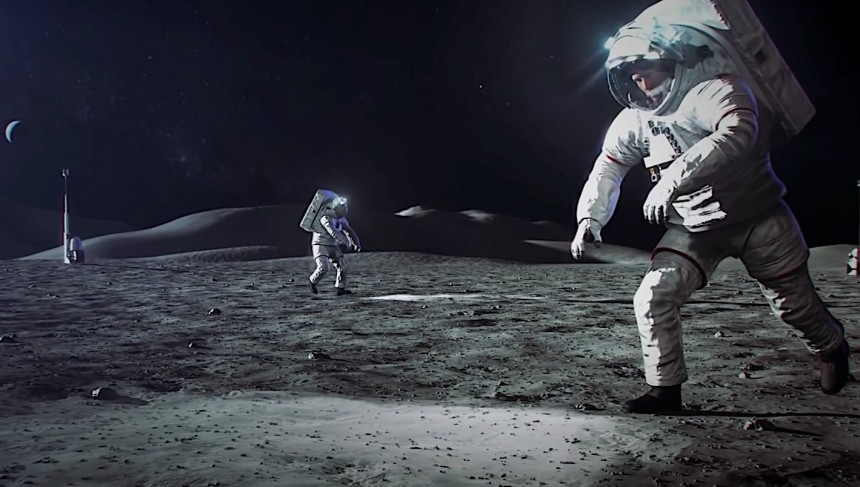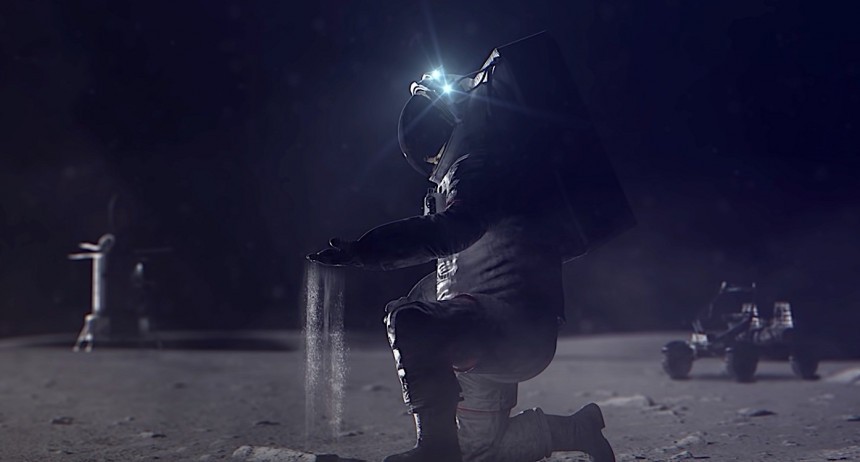As things stand today, the Artemis III Moon mission is scheduled to depart sometime in 2026. For all intents and purposes, it is perhaps the most important test of the program this decade, because it is very likely the future of space exploration efforts relies on its success.
Using the Space Launch System (SLS) rocket and the Orion spacecraft, a crew of four still unnamed astronauts, including the first person of color and the first woman, will leave our planet on a 30-day journey that will take them to the satellite's South Pole region and then back home.
Many of the details of the mission have already been ironed out, even if most of the tech that will support landing and surface operations is not nearly complete. But things are moving in the right direction, as this latest NASA announcement seems to prove.
NASA chose the South Pole of the Moon as a landing site first and foremost because it is there where some of the ball's of rock oldest regions reside. It's also a place filled with shadowed regions where valuable resources could be found.
The first piece of American equipment that is meant to support the Artemis mission is already on site there. On February 22, 2024, America's first private Moon lander, the Intuitive Machines Odysseus, touched down in the region, bringing with it to the surface several science instruments. Including what may very well be Luna's first-ever position beacon.
Until the launch of the Artemis III mission, NASA will continue to send science stuff to the Moon on private and uncrewed missions as part of the Commercial Lunar Payload Services (CLPS) program. This year alone, for instance, at least three more missions are planned, including the launch of the VIPER rover.
But not all science instruments can be delivered by means of uncrewed landers. If we are to truly understand what the Moon is all about and pave our way to Mars, more complex instruments are needed, and many of those can only be delivered and installed by humans.
The Artemis III mission is scheduled to do exactly that, and this week NASA announced the first three science instruments that will make it up there in human hands. They are all meant to collect data to "sustain a long-duration human presence on the Moon," but more importantly, "prepare NASA to send astronauts to Mars."
NASA says the tools we'll discuss a bit below are meant to help us better understand the Moon's processes, the origin of the volatiles present there, and get a better view of what danger means in such hostile environments. All three have been chosen to fly on Artemis III because humans are needed on-site for them to be installed and configured properly.
The first science instrument is called the Lunar Environment Monitoring Station, or LEMS. It was put together by a team from the University of Maryland, Baltimore County, led by Dr. Mehdi Benna.
LEMS is, in essence, an autonomous seismometer suite designed to continuously monitor lunar ground movements caused by moonquakes. It will be operational for anywhere between three months and two years, and it will help people here on Earth "characterize the regional structure of the Moon's crust and mantle." This, in turn, will inform scientists on lunar formation and evolution models.
If it works as intended, the LEMS may become the cornerstone of a future, more complex lunar geophysical network.
The second of three science instruments chosen so far for Artemis III is LEAF. That's an acronym for Lunar Effects on Agricultural Flora and it is the work of Space Lab Technologies in Boulder, Colorado, and its lead scientist, Christine Escobar.
As the name says, the tech is supposed to determine what kind of impact the lunar surface and the overall environment up there have on crops. Because, you know, no space colony would be functional without such things.
LEAF is described by NASA as the first instrument designed to give us a better understanding of how plant photosynthesis, growth, and systemic stress responses work in low-g and when subjected to space radiation.
The instrument will measure first and foremost plant growth and development data, but also environmental parameters. NASA hopes this would inform future colonists on how to grow their own food on the Moon (and ultimately Mars) for both food and life support.
The final major Artemis III experiment is the Lunar Dielectric Analyzer (LDA). More technical in nature, the name hides behind it: a measurement tool for the propagation of an electric field in the regolith, which is the stuff that makes up the surface of the Moon.
Electric field propagation is a key instrument for tools meant to find volatiles like ice. While doing its main work, LDA will also get intel on the subsurface monitor dielectric changes caused by the changing angle of the Sun as the Moon rotates, and look for possible frost formation or ice deposits.
This instrument is the work of the University of Tokyo and the Japanese space agency, with researcher Dr. Hideaki Miyamoto taking point on this.
Although these three science instruments are almost sure to go up to the Moon on the Artemis III Orion, NASA says "final manifesting decisions about the mission will be determined at a later date." That means after the three pieces of tech complete their development for the mission.
Many of the details of the mission have already been ironed out, even if most of the tech that will support landing and surface operations is not nearly complete. But things are moving in the right direction, as this latest NASA announcement seems to prove.
NASA chose the South Pole of the Moon as a landing site first and foremost because it is there where some of the ball's of rock oldest regions reside. It's also a place filled with shadowed regions where valuable resources could be found.
The first piece of American equipment that is meant to support the Artemis mission is already on site there. On February 22, 2024, America's first private Moon lander, the Intuitive Machines Odysseus, touched down in the region, bringing with it to the surface several science instruments. Including what may very well be Luna's first-ever position beacon.
Until the launch of the Artemis III mission, NASA will continue to send science stuff to the Moon on private and uncrewed missions as part of the Commercial Lunar Payload Services (CLPS) program. This year alone, for instance, at least three more missions are planned, including the launch of the VIPER rover.
The Artemis III mission is scheduled to do exactly that, and this week NASA announced the first three science instruments that will make it up there in human hands. They are all meant to collect data to "sustain a long-duration human presence on the Moon," but more importantly, "prepare NASA to send astronauts to Mars."
NASA says the tools we'll discuss a bit below are meant to help us better understand the Moon's processes, the origin of the volatiles present there, and get a better view of what danger means in such hostile environments. All three have been chosen to fly on Artemis III because humans are needed on-site for them to be installed and configured properly.
The first science instrument is called the Lunar Environment Monitoring Station, or LEMS. It was put together by a team from the University of Maryland, Baltimore County, led by Dr. Mehdi Benna.
LEMS is, in essence, an autonomous seismometer suite designed to continuously monitor lunar ground movements caused by moonquakes. It will be operational for anywhere between three months and two years, and it will help people here on Earth "characterize the regional structure of the Moon's crust and mantle." This, in turn, will inform scientists on lunar formation and evolution models.
The second of three science instruments chosen so far for Artemis III is LEAF. That's an acronym for Lunar Effects on Agricultural Flora and it is the work of Space Lab Technologies in Boulder, Colorado, and its lead scientist, Christine Escobar.
As the name says, the tech is supposed to determine what kind of impact the lunar surface and the overall environment up there have on crops. Because, you know, no space colony would be functional without such things.
LEAF is described by NASA as the first instrument designed to give us a better understanding of how plant photosynthesis, growth, and systemic stress responses work in low-g and when subjected to space radiation.
The instrument will measure first and foremost plant growth and development data, but also environmental parameters. NASA hopes this would inform future colonists on how to grow their own food on the Moon (and ultimately Mars) for both food and life support.
Electric field propagation is a key instrument for tools meant to find volatiles like ice. While doing its main work, LDA will also get intel on the subsurface monitor dielectric changes caused by the changing angle of the Sun as the Moon rotates, and look for possible frost formation or ice deposits.
This instrument is the work of the University of Tokyo and the Japanese space agency, with researcher Dr. Hideaki Miyamoto taking point on this.
Although these three science instruments are almost sure to go up to the Moon on the Artemis III Orion, NASA says "final manifesting decisions about the mission will be determined at a later date." That means after the three pieces of tech complete their development for the mission.

















